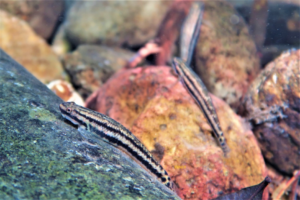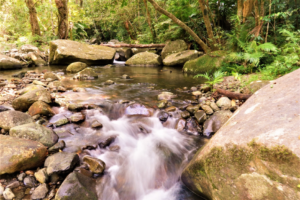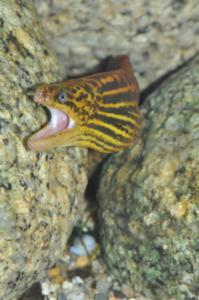Biodiversity of short-steep-coastal streams of the Wet Tropics
Introduction

In the past decade, TropWATER researcher Dr Brendan Ebner has discovered populations of 6 species of cling goby (small fish) not previously recorded from Australia. These species predominantly inhabit short-steep-coastal-streams (SSCS) characterised by very small catchments that drain directly to the ocean in high rainfall areas, and these ecosystems have only very recently been recognised as unique in the Australian landscape. Cling gobies are found in extremely low numbers in Australia and are essentially confined to a very small geographic area along the Wet Tropics coastline. One of these species, the Opal cling goby (Stiphodon semoni), is listed under the EPBC Act as Critically Endangered.

Another cling goby, the Rabbit-headed cling goby (Sicyopterus lagocephalus) is especially adapted to living in high flow environments typical of these steep high rainfall catchments. The Rabbit-head shrugs off flows in excess of 1 ms-1 and this was a focal interest of James Donaldson’s Honours study (via Australian National University, supervised by Dr Chris Fulton). A report has also been published from a collaboration between TropWATER researchers and the Far North Queensland Regional Organisation of Councils (FNQROC), as funded by the Queensland Department of Environment and Heritage Protection. That project achieved systematic mapping of cling gobies across sub regions of the Wet Tropics.

Collaborations and communication with a number of scientists working in the Pacific Island region have been a feature of TropWATER researcher’s gaining insight into cling goby ecology and the function of short-steep-coastal-streams. Among these collaborators are Gerry Allen, David Boseto, Ken Maeda, Philippe Keith, Gérard Marquet, Ida Midori, Philippe Gerbeaux, Clara Lord, Helen Larson, Robson Hevalao and of course Paul Thuesen.
The Freshwater moray is one of the few large-bodied species that inhabits some of these streams. There are also typically diadromous prawns and molluscs in this ecosystem type. Whilst some of these streams are nested within protected areas (e.g. at Cape Tribulation), several face increasing pressure from human effects associated with water extraction, riparian clearing, the spread of pest species, and there is potential for direct (illegal) collection of cling gobies for aquarium purposes.
Contact us for more information
Further reading
Donaldson, J. A., Ebner, B. C. & Fulton, C. J. (2013). Flow velocity underpins microhabitat selectivity in amphidromous gobies of the Australian Wet Tropics. Freshwater Biology 58, 1038–1051.
Ebner, B. C., Donaldson, J. A., S. Fulton, C. & Schaffer J. (2015). Distinct habitat selection by freshwater morays in tropical rainforest streams. Ecology of Freshwater Fish (Early view)
Ebner, B. C., Donaldson, J. D., Allen, G., and Keith, P. (2017). Testing an underwater video network and first record of Sicyopterus cynocephalus in Australia. Cybium 41, 117–125
Ebner, B. C., Donaldson, J. A. & Sydes, T. A. (2016). Conservation planning for cling gobies and short-steep-coastal-streams in the Australian Wet Tropics. Centre for Tropical Water & Aquatic Ecosystem Research (TropWATER) Publication, James Cook University, Cairns, 68 pp. (Report No. 16/25)
Ebner, B. C., Kroll,R., Godfrey, P., Thuesen, P.A., Vallance, T., Pusey, B., Allen,G., Rayner, T. S., Perna, C. N. (2011b). Is the elusive Gymnothorax polyuranodon really a freshwater moray? Journal of Fish Biology 79, 70–79.
Ebner, B. C., Thuesen, P. A., Larson, H. & Keith, P. (2011a). A review of distribution, field observations and precautionary conservation requirements for sicydiine gobies in Australia. Cybium 35, 397–414.
Ebner, B. C. & Thuesen, P. A. (2010). Discovery of stream-cling-goby assemblages (Stiphodon species) in the Australian Wet Tropics. Australian Journal of Zoology 58, 331–340
Keith, P., Lord, C., Boseto, D. & Ebner, B. C. (2016). A new species of Lentipes (Teleostei: Gobiidae) from the Solomon Islands. Cybium 40, 139–146
Kroon F.J., Philip S., Donaldson J., Ebner B. (2014) Assessment of freshwater ecosystem condition, status and trends in the Wet Tropics region. Supporting study to the Wet Tropics Water Quality Improvement Plan. CSIRO, Australia.
Mennesson, M. I., Keith, P., Ebner, B. C., & Gerbeaux, P. (2016). Eleotris bosetoi (teleostei: Gobioidei: Eleotridae), a new species of freshwater fish from the Solomon Islands. Pacific Science, 70, 495-507
Thuesen P. A., Ebner, B. C., Larson, H., Keith, P., Silcock, R. M., Prince, J. & Russell, D. J. (2011). Amphidromy links a newly documented fish community of continental Australian streams, to oceanic islands of the West-Pacific. PLOS One 6, e26685
Wet Tropics Management Authority (2013). Annual Report and State of the Wet Tropics report 2012–2013. Cairns: Wet Tropics Management Authority

